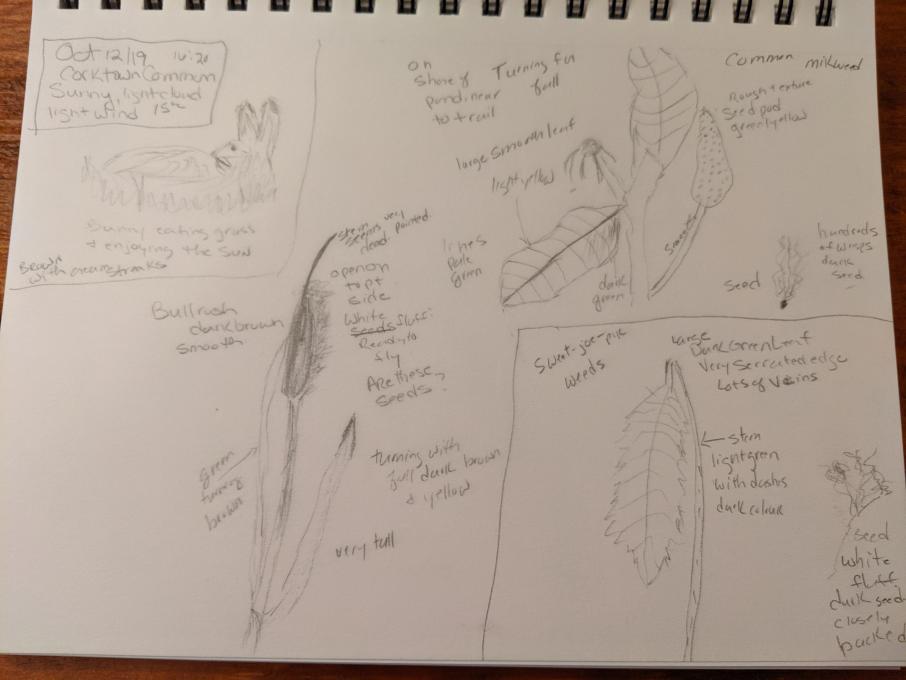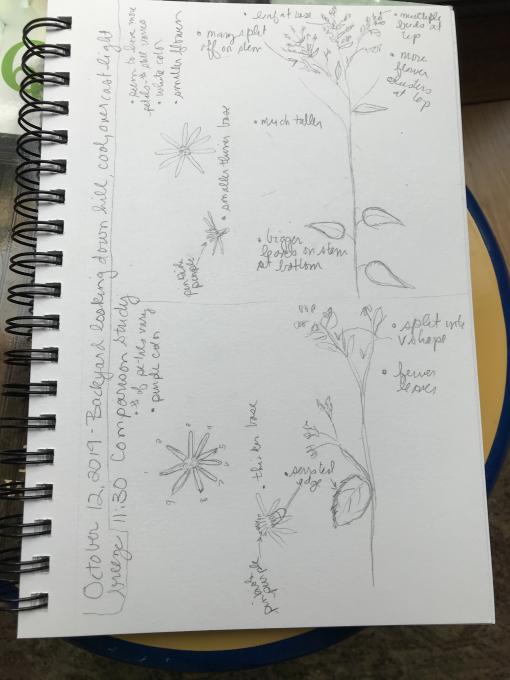The Cornell Lab Bird Academy › Discussion Groups › Nature Journaling and Field Sketching › The Power of Comparison
-

I did this exercise indoors because the weather was very bad today, I think my observation would have benefitted from being outdoors and also comparing leaves, branch and bark of the two trees. Now looking at other submissions I'd like to include scale measurements in upcoming drawings as well. -
Not a great time to be drawing outdoors, so I collected two flowers from my garden and did my comparison inside where it was dry and warm. I know the Hummingbirds and Bumblebees enjoy the red flower. Not 100% sure about the white one. I’ll have to make note next spring in my nature journal.

-
I love your printing and how you've placed things on the pages. Will need to work on that since I don't have a decision about how I'll journal and draw.
-
Hi Elizabeth, your journal page resonates! I appreciate the layout you used, wrapping your beautiful printing around the images, and I can sense the water in the vase. Your use of shading, darker and lighter lines, and mark making reminds me to not be shy in the pressure I apply to the pencil. Thank you for sharing your page.
Cheers, Laurie -
Your page is so beautiful it could be printed in a botany book. I'm jealous.
-
-
I enjoyed a lot this exercise because observing better each plant you find many different features in each specimen that you did not notice before.
After drawing the first specimen, I could find more features in the second one and started finding new ones in the first one too. Seeing things in one plant, makes you realize that the other does not have it.
I forgot to measure my specimens, but in order to write the measurements, we can start with measures and then with characteristics and after that drawing. After drawing we can notice more new characteristics we found during the drawing process.
.
-

(it WAS sunny earlier today!
By the time I finished work, and cooking dinner, it was dark, so I used the acorn and Halesia seed I had collected a few weeks ago. The side by side comparison appeals to me, and urged me on to research the trees further. Didn't realized that Halesia seeds aren't a food source for wildlife, but did know that acorns are an important food source for turkeys and deer.
Have found no explanation for the wings of the Halesia's seed pods, made a note of my question for further research. -
i had trouble with this at first, but i'm so glad i did it. I have both Goldenrod and Mugwort in the same part of my yard. when the goldenrod is done blooming, it can be very hard to tell them apart. but taking time to note the small details, helped me see the differences. Surprisingly, i also noticed a lot of similarities, especially in the flower buds. they have very similar height, and spacing where they grow, and very similar colors. Oh and the smell of mugwort. so lovely!
Although my first focus was on drawing and painting in this course, i'm starting to really like taking notes. I hardly ever write with a pencil anymore, it's tough, but good to keep the skill alive! (i say as I type).. :)

-
A comparison study is a very interesting way to manage and maintain my small garden properties. As October settles in central MA the plants and trees in my West Garden [almost all perennials] have gone to seed. Today I attempted to use Fuller's idea to contrast the one plant of Silvermound Wormwood I purchased and planted and the enormous quantity of 'Hens & Chicks' I received from a favorite aunt. They both seem to be spreading plants [I know the Hens & Chicks is]. I could see green, healthy looking portion of the Wormwood & on it's strongest stems there appeared to be bits of smaller , green. Before graying the leave, still feathery, turn yellow and start to curl.
Hens & Chicks are VERY sturdy. The most tender of leaves remain green. The outer leaves are clearly seed hulls that release to open up the green within. I never saw it bloom, except except in my own garden. I have to look up whether a plant can be biennial. One can clearly see the flower stems all gray,brown then topple and reproduce spread & grow.
Both plants have mounding ways of growing and make them pretty at the garden's edge.
It's really difficult sketching as a left handed artisan. I use my eraser [and thankfully] keep a draftsman's brush in my basket.
Without a doubt recording date, # of day and numerical data would help spark visions and make memories clearer
Reply
t -
I went ALL the way to my front courtyard to compare two orange flowers: lantana and marigolds. It was interesting to really look at the structure of their flowers, buds, and leaves. I had to try a Venn diagram to compare and contrast - I was surprised that I needed more in the "both have" central area than the outer areas, but I ran out of room in both sections and went to making notes next to the sketches. I had never noticed the pattern on the lantana of growing two flowers for each pair of leaves or that the marigold leaves were four or five matched pairs with a larger central leaf at the top. I found the flower structure on the lantana to be especially interesting. I enjoyed the activity and will do it again!

-

I compared these 3 discovered feathers. I know the Blue Jay and Downy Woodpecker, and not the middle, which was a very uniform gray with a white edge. It was about the same size as the jay, but more slender. The uniformity of color has me confused, Mockingbirds and Mourning Doves have patterns. This comparison study helped me to focus on feather length and detail. Another few questions I have is why do some birds appear to have more ‘fluff’ at the attachment end than others. Is the fluff related to their ability to keep warm in winter, thus not having to migrate?-
Great idea for a subject! I'll try it!
-
Very nice drawing! I found this great website for feather identification called the feather atlas, I’ve used it several times. fws.gov
-
-
 My comparative study is of a zinnia and another purple flower in my garden. The zinnias died back in the frost last weekend and the purple flower that I waited all summer to see blossom, popped into bloom with the frost.
My comparative study is of a zinnia and another purple flower in my garden. The zinnias died back in the frost last weekend and the purple flower that I waited all summer to see blossom, popped into bloom with the frost.
I am now wondering what pollinates this flower and how it propagates itself, the flowers are in clusters at the top of the stem whereas the zinnia has a single flower at the end of the stem.
The stink bugs and Asian lady beetles were buzzing us the whole time we were out drawing...ahhh... Autum in New Hampshire, the foliage is awesome this year.
-
Noticing the variety of tubular flowers that still attract all sizes of birds and insects.
Two I've noted in my journal are a Tropical Mandeville with large tubular flowers and Blue Salvia that have tall stalks with clusters of smaller tubular flowers.
I would have expected Hummingbirds to be more attracted to the larger flower, but there may be a difference in the quality, quantity or accessibility of the nectar since birds, bees and butterflies are all attracted to the Salvia more consistently. Flowers are smaller, but many more of them and they bloom over a long period from beginning of summer through early freezes. As soon as the temp warmed up even slightly today the bees and Painted Lady butterflies were back. Painted Ladies used to drive each other, and bees/hummingbirds off the plant, but now they are cooperating and just working their own corners of the plant.
Will make a chart of the flowering plants in my yard to record what blooms attracted which wildlife.
-
Your drawings are lovely. What tools do you use for the color? Pencils? Markers? Watercolors? Thank you.
-
@Janice Thank you for the kind words. I used both watercolor pencil and the larger areas were the Koi 24 color travel set I'd gotten from Amazon. I haven't done much with watercolor pencil so this is a learning experience and really want to work on getting shading on the leaves. Many shades of green, but I'd read about using Gouache for lighter highlights so will try it.
-
-
 I couldn’t find 2 lovely flowers, so I used 2 trees that were side by side—an oak and a cottonwood. It was almost like they were living in two different forests—the cottonwood was very flexible, blowing in the wind, with many of its leaves blown off. The oak barely moved in the wind, and still had most of its leaves. I found it challenging to suggest the texture of the two different trees without drawing individual leaves. I like having the inset single leaves; they make each of the trees more present to me.
I couldn’t find 2 lovely flowers, so I used 2 trees that were side by side—an oak and a cottonwood. It was almost like they were living in two different forests—the cottonwood was very flexible, blowing in the wind, with many of its leaves blown off. The oak barely moved in the wind, and still had most of its leaves. I found it challenging to suggest the texture of the two different trees without drawing individual leaves. I like having the inset single leaves; they make each of the trees more present to me.
The structure of the trees really varied. The oak had sturdy branches that reached up, and was dense with leaves. The cottonwood had fewer, more fluttery leaves, very responsive to the wind. Its branches drooped and swayed. I thought its wood is probably softer than the oak’s. -

-
 I decided to continue with my Franklinia. I had real trouble with the water drops on white flowers and and shading the flowers and leaves. I learned that I need a lot of time. I forgot to take a ruler with me to show scale.
I decided to continue with my Franklinia. I had real trouble with the water drops on white flowers and and shading the flowers and leaves. I learned that I need a lot of time. I forgot to take a ruler with me to show scale. -
I went to a local wetland park, Corktown Common. I walked around the wetland and found a brown rabbit eating grass in the sunshine. I managed a quick sketch of the bunny before they were scared by skateboarders. I continued to the wetland area and did a comparison of three plants which all had seeds that blow away. The Common Milkweed, A Bulrush and Sweet Joe-Pye. As it is fall, the seeds were blowing, the leaves were no longer bright green and the signs of decay were all around. I really enjoyed doing this and was surprised by how many people stopped and asked questions of me about my drawing and the park.

-
This one was hard. I went into my back yard and had a hard time finding something to compare. A lot of the plants are fading and going to seed. I chose two small wild flowers. The were very similar and I think that is what made it. I was frustrated toward the end.
\challenging.
Read More:
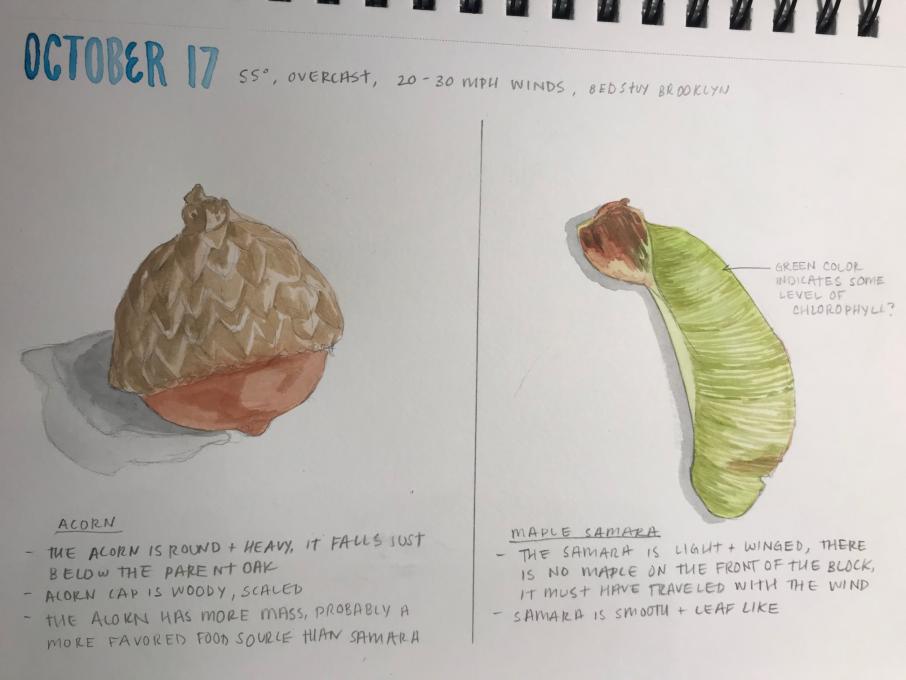
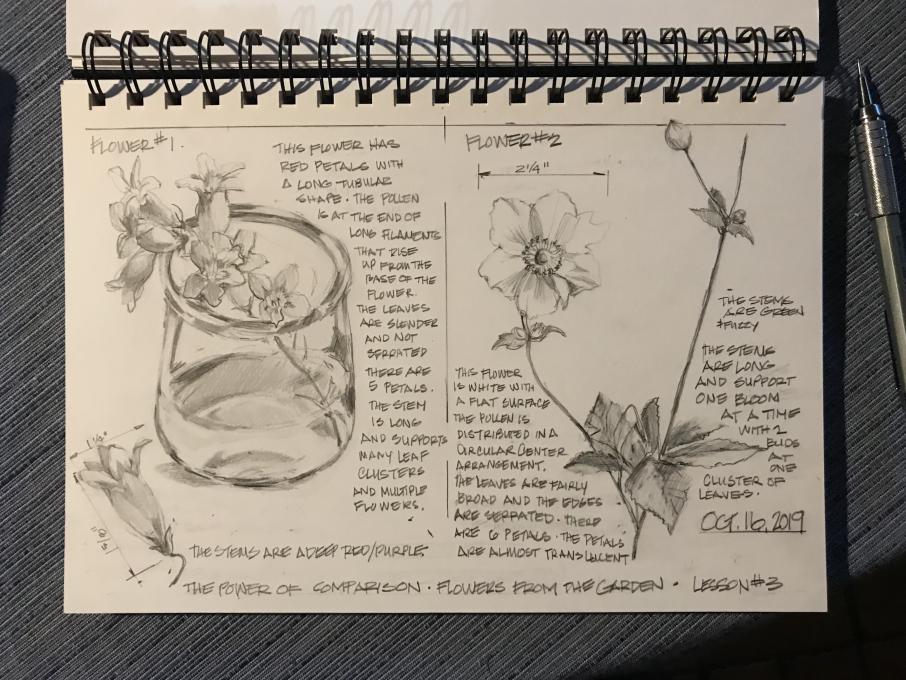
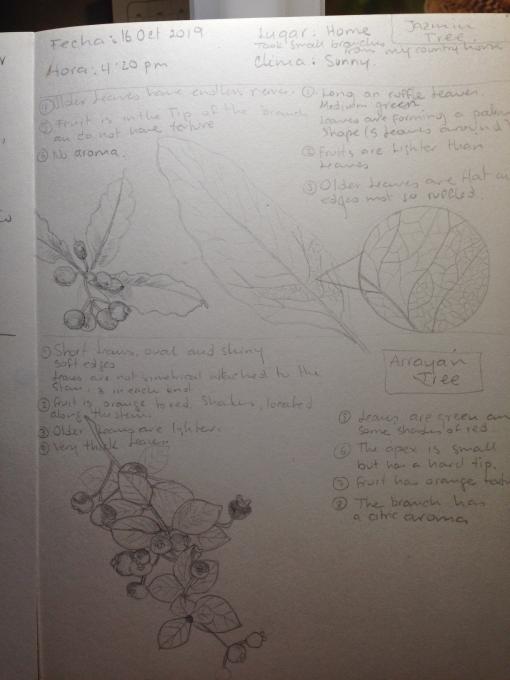
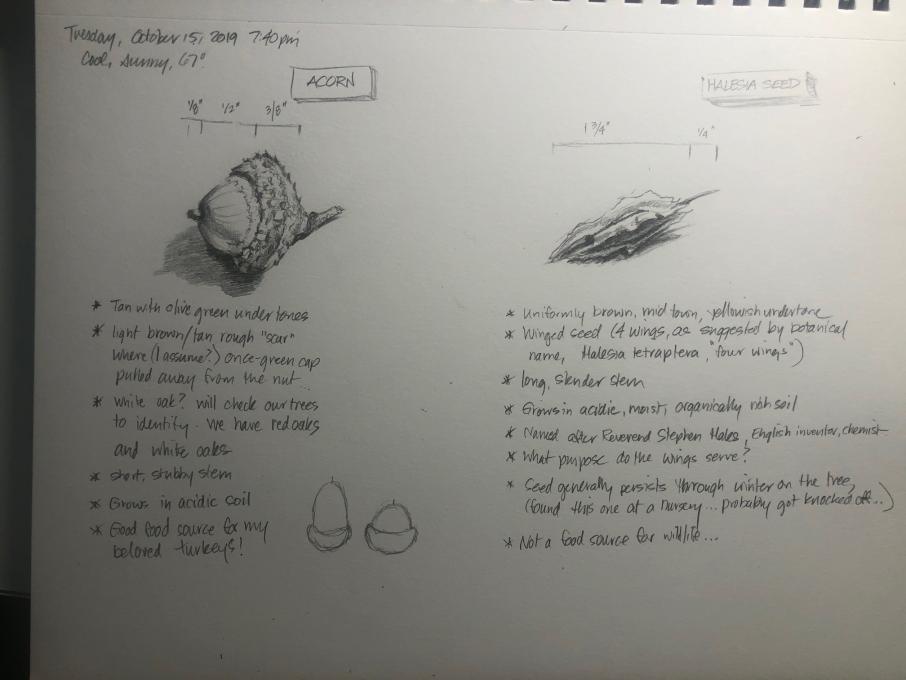
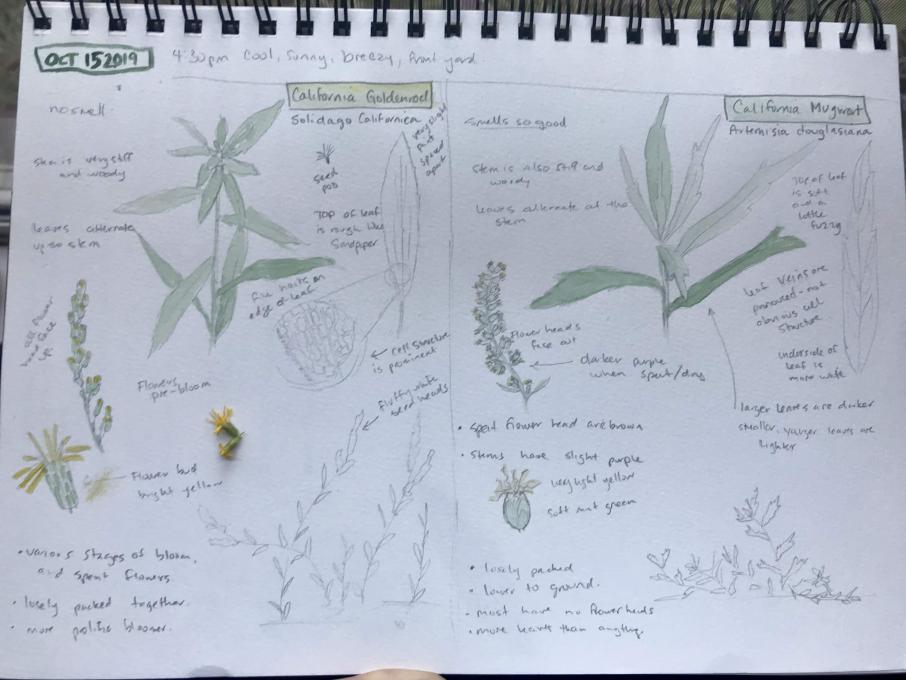
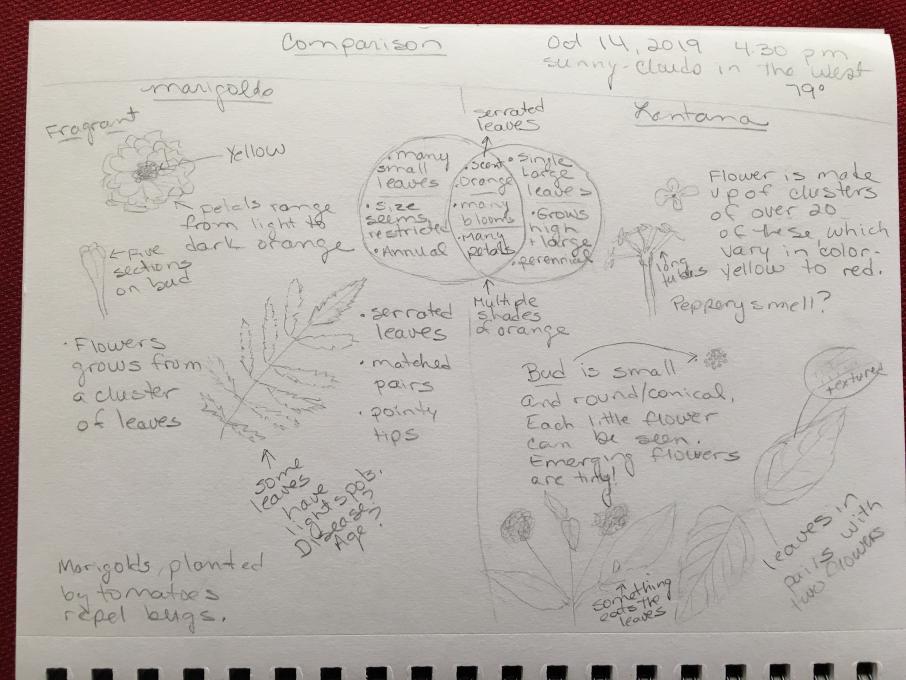
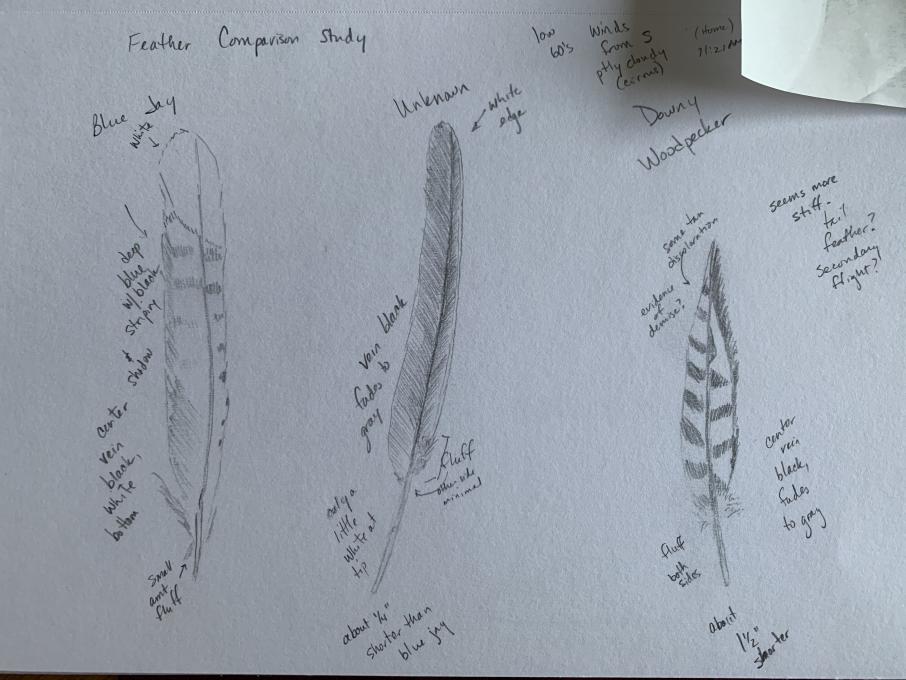
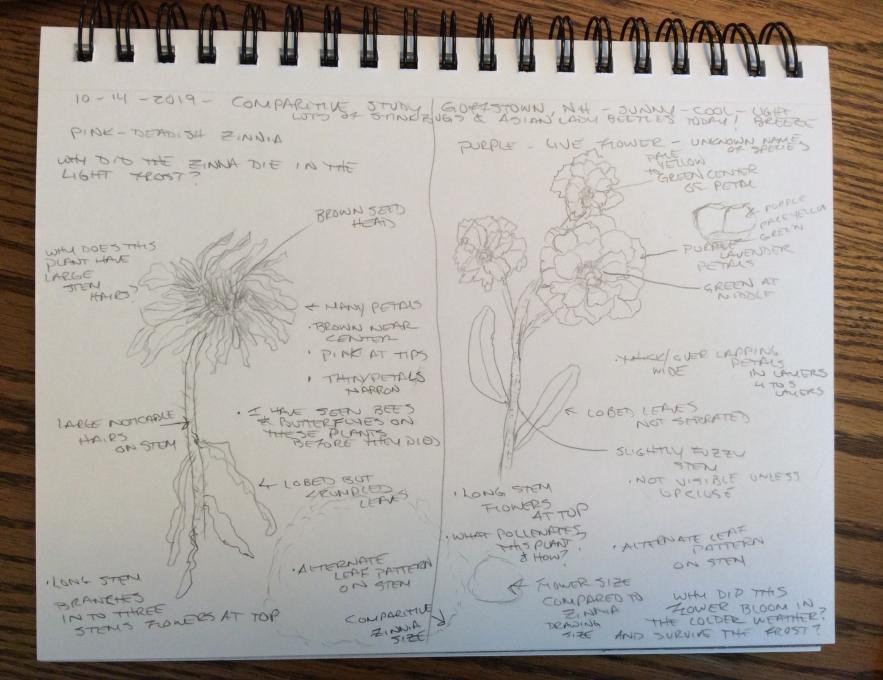 My comparative study is of a zinnia and another purple flower in my garden. The zinnias died back in the frost last weekend and the purple flower that I waited all summer to see blossom, popped into bloom with the frost.
My comparative study is of a zinnia and another purple flower in my garden. The zinnias died back in the frost last weekend and the purple flower that I waited all summer to see blossom, popped into bloom with the frost.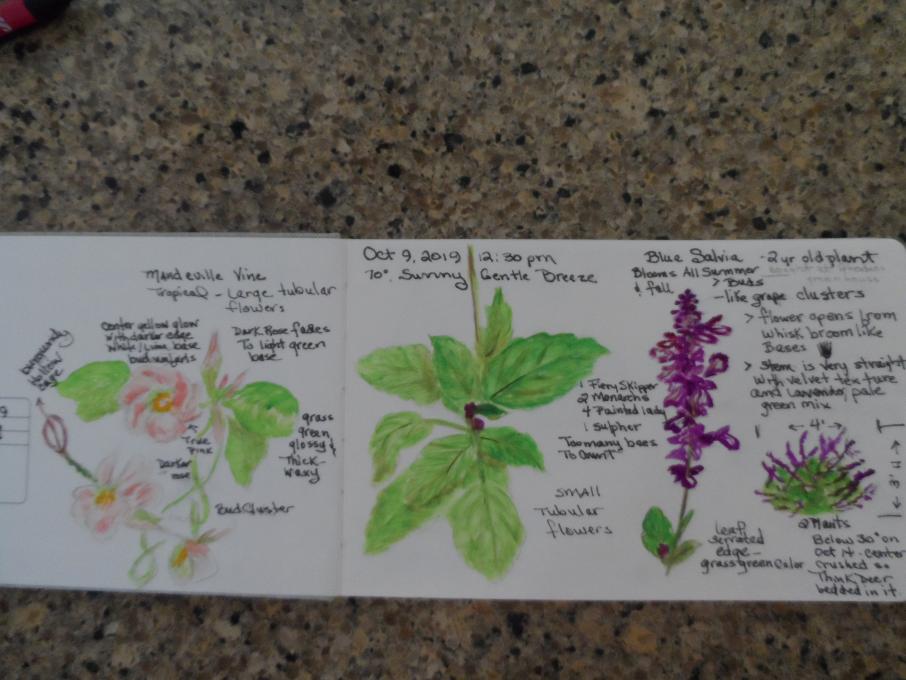
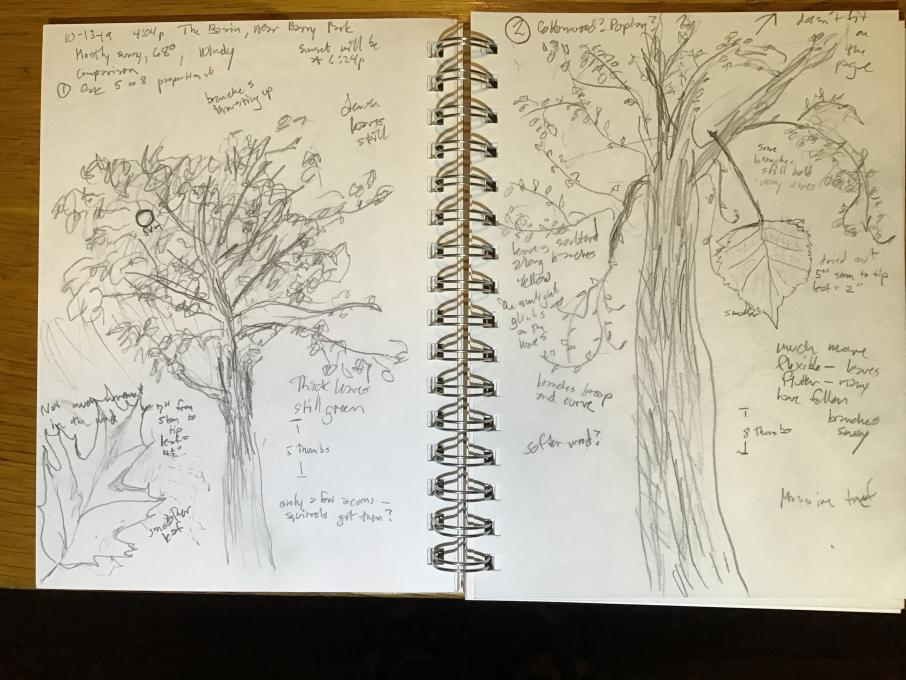 I couldn’t find 2 lovely flowers, so I used 2 trees that were side by side—an oak and a cottonwood. It was almost like they were living in two different forests—the cottonwood was very flexible, blowing in the wind, with many of its leaves blown off. The oak barely moved in the wind, and still had most of its leaves. I found it challenging to suggest the texture of the two different trees without drawing individual leaves. I like having the inset single leaves; they make each of the trees more present to me.
I couldn’t find 2 lovely flowers, so I used 2 trees that were side by side—an oak and a cottonwood. It was almost like they were living in two different forests—the cottonwood was very flexible, blowing in the wind, with many of its leaves blown off. The oak barely moved in the wind, and still had most of its leaves. I found it challenging to suggest the texture of the two different trees without drawing individual leaves. I like having the inset single leaves; they make each of the trees more present to me.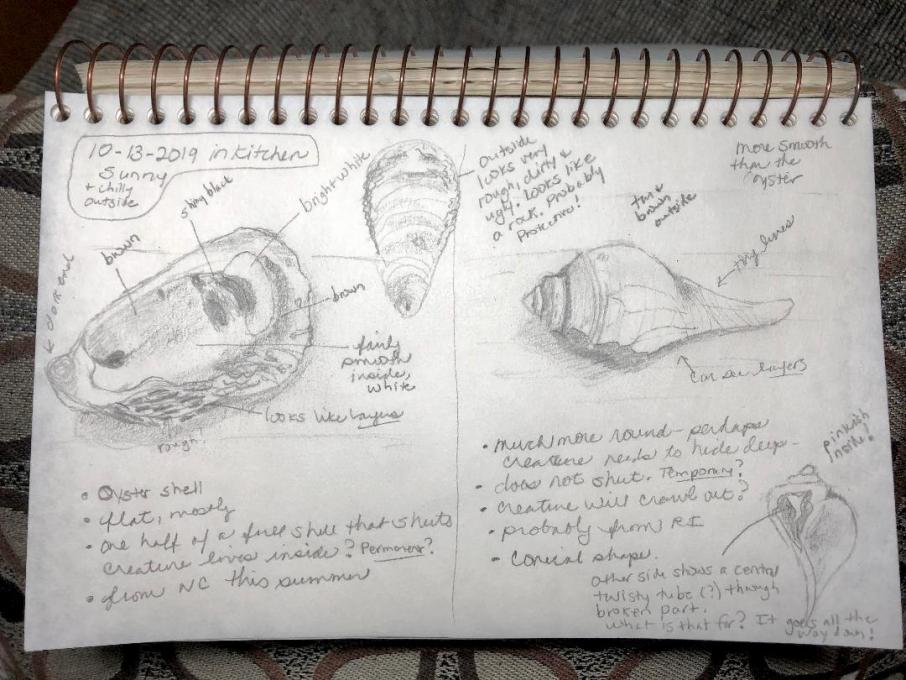
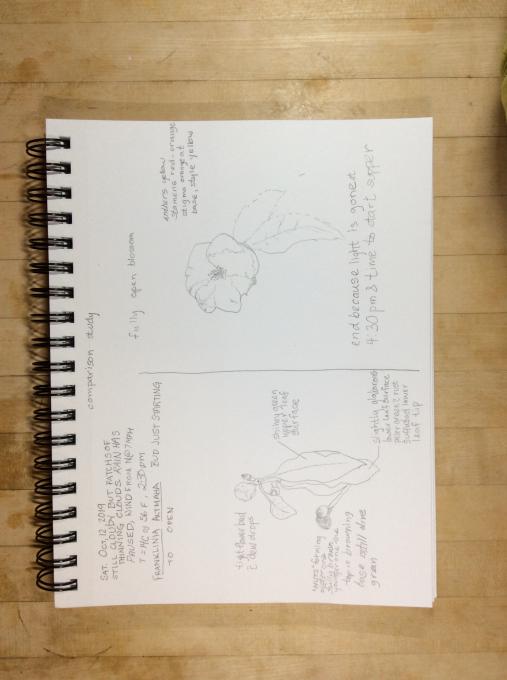 I decided to continue with my Franklinia. I had real trouble with the water drops on white flowers and and shading the flowers and leaves. I learned that I need a lot of time. I forgot to take a ruler with me to show scale.
I decided to continue with my Franklinia. I had real trouble with the water drops on white flowers and and shading the flowers and leaves. I learned that I need a lot of time. I forgot to take a ruler with me to show scale. 